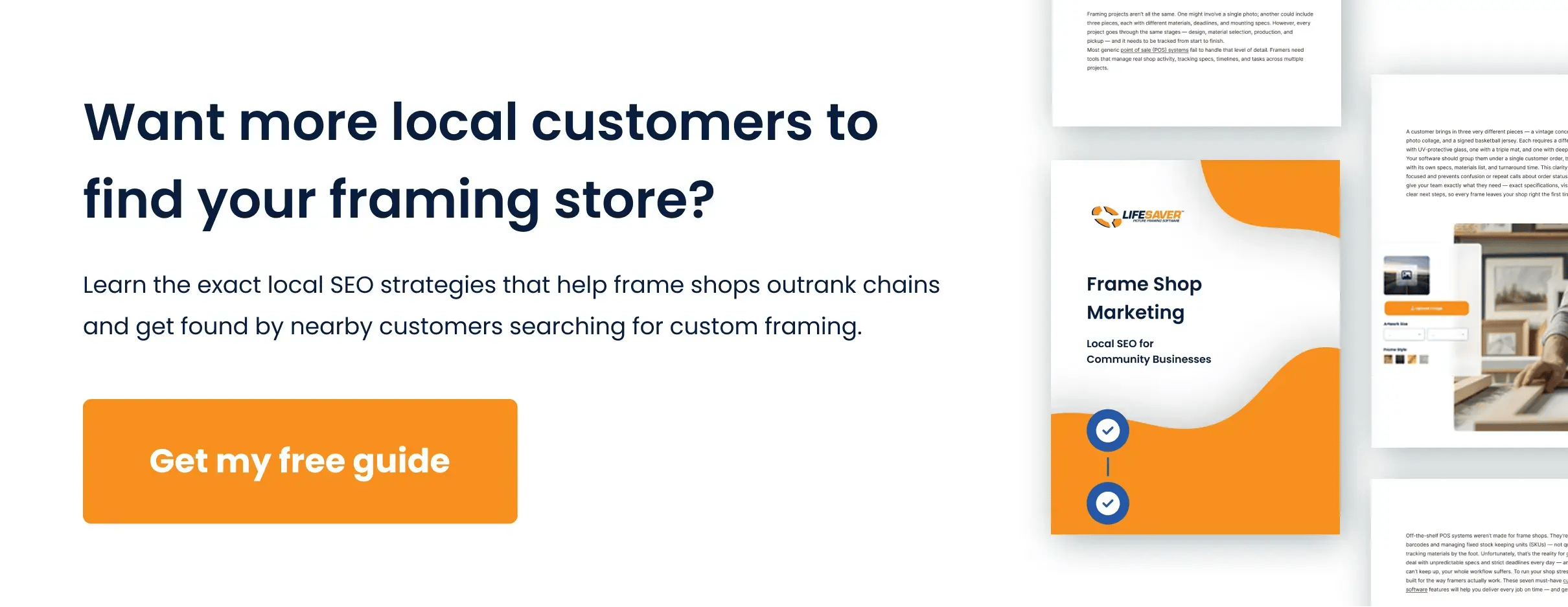
If your framing store isn’t showing up in local search results, you’re losing business to the shop down the street. Whether someone needs a custom mat cut or a last-minute gift frame, they’re turning to Google first — and expecting instant results nearby.
More than 30% of U.S. consumers search for local businesses daily, often using Google Maps or Search to find what they need fast. If your store doesn’t appear when they type in “custom framing near me,” you might as well be invisible.
Explore seven best practices for local SEO — short for search engine optimization — to help your shop stand out online, generate more in-store sales, and send more foot traffic where it counts — through your front door.
1. Claim and Optimize Your Google Business Profile
Your Google Business Profile is one of your most crucial local SEO tools. It shows up in Google Maps and search engine results when someone types your business into a search engine or looks for “framing [your city]”. Your profile gives customers details like your hours, location, services, reviews, and photos before they decide to visit.
Here’s how to claim and set up your profile:
- Claim your listing at Google.com/business, click “Manage now,” and follow the steps to verify your store.
- Use the same name, address, and phone number (NAP) as what’s listed on your website and social media profiles.
- Select the most relevant categories for your store, like “Picture Frame Shop” or “Custom Framing Services,” to show up in the right service.
- Upload high-quality photos of your storefront, workspace, and finished frame jobs. Avoid using stock images.
- Turn on messaging and update business hours to make it easy for people to reach you and know when you’re open.
With a complete, up-to-date profile, you’re letting Google know you’re active — and you’re letting customers know your store is worth a visit.
2. Use a Consistent NAP Across the Web
Your NAP needs to be identical everywhere your business is listed. Google uses this consistency to confirm your business details and rank you higher in local search.
Here’s how to keep it consistent across all listings:
- Check your website, Google Business Profile, and social media for any mismatches.
- Search for your business name online and update old directory listings with current details.
- Use tools like Moz Local or BrightLocal to find inconsistent or duplicate listings.
- Stick to the same format every time, including abbreviations and punctuation.
Even minor inconsistencies can hurt your visibility and make it harder for customers to find you. Maintaining consistent details across profiles is one of the easiest best practices for local SEO.
3. Encourage and Respond to Customer Reviews
Reviews influence customer buying decisions and local SEO rankings. 93% of consumers say online reviews affect what they buy, and Google uses review quantity and quality (alongside relevance and distance) as part of its local ranking factors.
To encourage customers to leave reviews:
- Ask satisfied customers for a review after pick-up or via follow-up email.
- Link directly to your Google, Yelp, or Facebook review pages to make it easy.
- Reply to all reviews — especially the negative ones — with professionalism.
- Work in keywords like “canvas stretching” or “custom shadow box” when responding to or commenting on reviews.
Framing is visual and personal. When customers describe the quality of care they put into a piece, that carries real weight with the next person searching.
4. Add Location Pages to Your Website
Dedicated location pages on your website focus on one specific store or service area. If you have multiple shops — or serve more than one city — these pages allow Google to connect each location to local searches and help customers find the right store.
Each page should include important information:
- Write a short introduction about the store and the area it serves.
- Add your full address, phone number, and store hours.
- Mention local landmarks, parking information, or public transit options.
- Work in phrases like “custom framing in [City]” naturally in headers and text.
Framers rely on local foot traffic. These pages help you show up in “near me” searches and guide people straight to your door.
5. Publish Locally Relevant Content
Most small business websites are static, but fresh, and local content gives Google a reason to keep indexing your site and helps customers see your framing shop as active and community-based. Regular updates are among the best practices for local SEO, showing that you’re involved, skilled, and up to date.
Framers should consider the following content ideas:
- Write short blog posts about art fairs, gallery openings, or local décor trends.
- Showcase artists you’ve worked with and frame jobs tied to community events.
- Highlight local collaborations, like framing for galleries, schools, exhibitions, or workshops.
- Drop in location terms naturally — like “framed this concert poster for a client in [City]” or “our latest custom frame job for a [City] gallery.”
Add this content to your blog or a “What’s New” section on your homepage. This isn’t filler — it’s proof you’re part of the creative life of your city.
6. Optimize for Mobile and Page Speed
Mobile traffic dominates local search. Over 63% of website visits in 2025 will come from mobile devices, and more than 96% of internet users browse the web on their phones. If your site loads slowly or doesn’t display correctly, you’ll lose customers before they even see your services.
Here’s how to keep mobile users from bouncing:
- Use Google’s PageSpeed Insights to scan your site and flag slow-loading elements.
- Compress large images, especially gallery or product photos.
- Use a responsive design that adjusts to phone and tablet screens.
- Test that buttons, forms, and menus are easy to tap.
Around half of your website’s visitors won’t wait longer than two seconds for the page to load. If your site lags, they’ll choose the next framing website that loads faster.
7. Use Local Schema Markup
Local schema markup is background code you add to your site that helps Google read and display critical business details — like your hours, services, and reviews — directly in search results. It won’t change what’s on your website, but it can improve how you market your business and how your listing appears in the “local pack.”
For example, if someone searches for “custom framing near me,” the schema can help Google pull up your business with a photo, star rating, and store hours all in the result.
Here’s how to add it:
- Use Google’s Structured Data Markup Helper to generate the code.
- Copy and paste the code into the <head> section of each location or contact page.
- Ask your web developer for help if you use a custom-built site or theme.
Schema isn’t something customers see, but it helps Google display your shop more clearly, rank it more accurately, and connect you with the right local searches.
Turn Best Practices for Local SEO Into More Foot Traffic and Sales
Local SEO isn’t a marketing checkbox — it’s how new customers find your store, judge your credibility, and decide whether to buy from you. Following these best practices for local SEO helps your framing shop rank in search results and turn online searches into real-world visits.
As your visibility grows, you need a point of sale (POS) system that can keep up. LifeSaver POS is designed for custom framers, with vendor integrations that sync pricing with top suppliers, and tools to create detailed custom quotes, work orders, and marketing tools for follow-ups. You also get advanced reporting to track what’s working and where you need to grow next.
Claim your 14-day free trial to see how LifeSaver can support your shop at every stage.

Jun 24, 2025 10:35:01 AM





